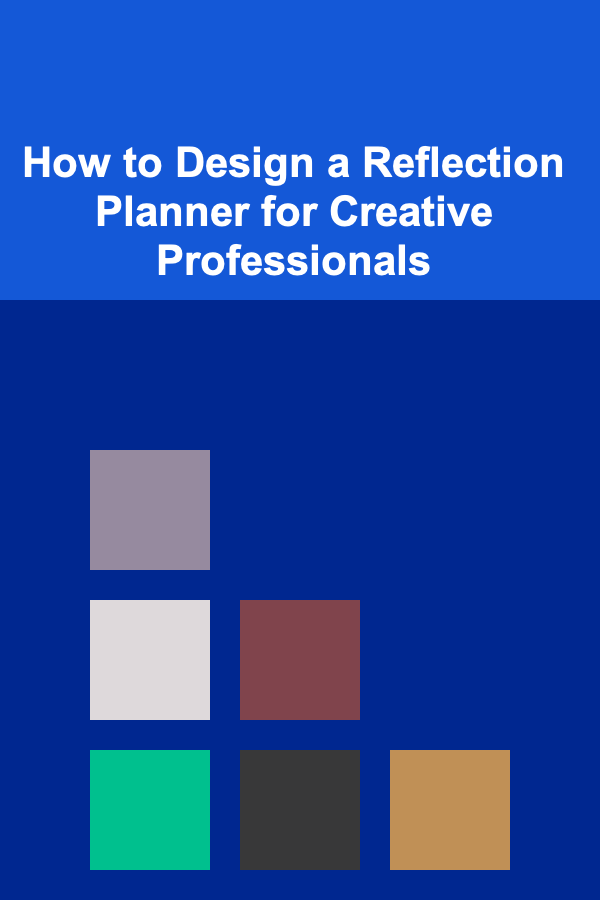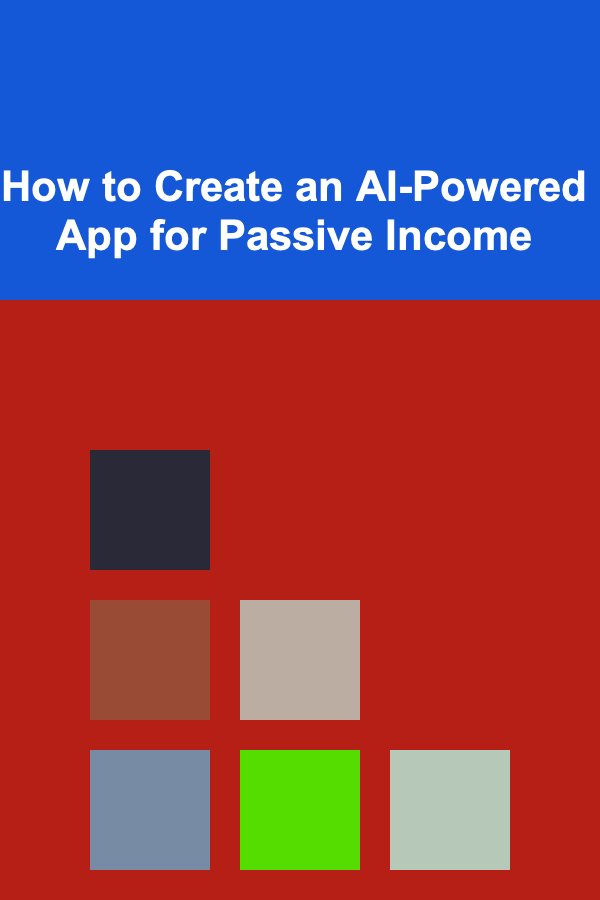
How to Design a Reflection Planner for Creative Professionals
ebook include PDF & Audio bundle (Micro Guide)
$12.99$9.99
Limited Time Offer! Order within the next:

Reflection is a powerful tool that helps creative professionals develop insight, nurture growth, and enhance their craft. For artists, writers, designers, and other creatives, a dedicated reflection planner can serve as an invaluable resource to capture thoughts, monitor progress, and foster continuous improvement. Designing such a planner requires understanding both the creative process and how reflection supports it.
In this article, we will explore the conceptual foundation of a reflection planner tailored for creative professionals and then guide you through the practical steps to design a planner that inspires deep reflection, encourages productivity, and aligns with the unique needs of creative work.
Understanding the Importance of Reflection in Creative Work
Before diving into the design aspects, it is essential to understand why reflection matters so much for creative professionals.
1. Reflection Fuels Creativity and Innovation
Creativity thrives when individuals pause to assess their work critically. Reflection helps uncover insights that might otherwise remain hidden in the rush of production. It is during reflective moments that new connections form, ideas evolve, and innovative solutions emerge.
2. Reflection Enables Self-Awareness and Growth
By regularly reflecting, creatives gain self-awareness about their strengths, weaknesses, habits, and emotional responses. This awareness is crucial for personal and professional growth. It allows creatives to identify patterns, overcome blocks, and develop resilience.
3. Reflection Supports Intentional Practice
Creative skills improve with intentional practice---focused, goal-oriented repetition. A reflection planner can help creatives track their practice, evaluate outcomes, and adjust strategies, making their efforts more effective.
4. Reflection Prevents Burnout and Sustains Motivation
Creative work can be emotionally and mentally taxing. Reflection provides a space to acknowledge challenges, celebrate achievements, and maintain motivation. It helps creatives balance productivity with well-being.
Key Principles for Designing a Reflection Planner
Designing a reflection planner is not just about creating a notebook or template; it's about crafting an experience that encourages meaningful engagement with one's creative journey. Here are some core principles to guide the design:
1. User-Centered Design
Understand your target users deeply. What are their creative disciplines, workflows, challenges, and goals? The planner's structure and prompts must resonate with their needs.
2. Balance Structure and Flexibility
Too much structure can stifle creativity; too little can lead to underuse. The planner should provide enough guidance to inspire reflection without feeling restrictive. Consider including optional prompts alongside free-form space.
3. Promote Regularity Without Pressure
Reflection is most effective when practiced consistently but should never feel like a chore. Design the planner to encourage regular check-ins (daily, weekly, monthly), but allow users to adapt frequency based on their rhythm.
4. Incorporate Visual and Textual Elements
Creative professionals often think visually. Incorporate areas for sketches, mind maps, or doodles alongside written reflections to accommodate different thinking styles.
5. Encourage Forward Thinking
Reflection isn't just about looking back; it's about moving forward with intention. Include prompts that help users set goals, plan experiments, and envision future projects.
Step-by-Step Guide to Designing a Reflection Planner
Step 1: Define the Planner's Purpose and Scope
Start by articulating what the reflection planner aims to achieve. Examples include:
- Helping creatives track progress on projects
- Encouraging regular creative self-assessment
- Supporting mental and emotional well-being
- Facilitating goal setting and strategic planning
Decide on the planner's time frame. Will it be a daily, weekly, monthly, or project-based planner? Or a combination?
Step 2: Identify Core Sections
Most reflection planners contain several key sections. For creative professionals, consider including:
-
Daily Reflection Pages
Capture immediate reactions, moods, breakthroughs, or challenges experienced each day.
-
Project Logs
Track individual projects with notes on objectives, progress, feedback, and lessons learned.
-
Creative Idea Bank
A space to jot down spontaneous ideas, inspirations, or references for future exploration.
-
Goal Setting and Review
Define creative goals and periodically review them to stay aligned with your vision.
-
Mood and Energy Trackers
Track mental and physical states to understand how they influence creative output.
-
Resource and Inspiration Lists
Catalog books, podcasts, artworks, or people that spark creativity.
Step 3: Develop Reflective Prompts
Craft thoughtful prompts that spark deep reflection. Prompts should encourage honest, insightful responses and help users uncover new perspectives.
Examples:
- What was the most fulfilling part of my creative process today?
- What obstacles did I encounter, and how did I address them?
- What emotions did this project evoke, and what can I learn from them?
- How did I experiment or take creative risks today?
- What feedback did I receive, and how will I integrate it?
- What is one small step I can take tomorrow to move this project forward?
Balance open-ended prompts with more focused questions to guide thought while allowing space for free expression.
Step 4: Design Layouts that Encourage Use
The planner's visual design affects usability and engagement. Key considerations:
- Whitespace: Leave generous margins and blank spaces for sketches, notes, or mind maps.
- Typography: Use clear, legible fonts with a hierarchy that distinguishes prompts, headings, and user responses.
- Color: Integrate calming or inspiring color schemes that reflect creativity but do not overwhelm.
- Size: Choose a physical or digital size that fits users' lifestyles (e.g., portable notebooks, printable PDFs, or app layouts).
- Modularity: Design pages or sections that users can reorder, duplicate, or skip, enabling personalization.
Step 5: Incorporate Tools for Tracking and Visualization
Visual tracking supports reflection by making progress and patterns tangible.
- Progress Bars or Checklists: For goals or daily practices.
- Mood/Energy Graphs: Simple icons or charts to plot emotional or physical states over time.
- Project Timelines: Visualize key milestones and deadlines.
- Creative Habit Trackers: Track activities like sketching, journaling, or brainstorming.
Step 6: Include Guidance and Examples
Provide clear instructions and examples on how to use the planner. This might be a preface or occasional tips throughout. Explain why reflection matters and how to get the most out of the planner.
Step 7: Prototype and Gather Feedback
Create a prototype (print or digital) and test it with creative professionals. Collect feedback on usability, content relevance, and overall experience. Iterate to improve clarity, functionality, and appeal.
Step 8: Finalize and Produce
Once refined, produce the planner in the desired format(s). Consider offering it as a downloadable PDF, physical notebook, app, or combination.
Sample Reflection Planner Framework for Creative Professionals
Here is an example framework illustrating how the sections and prompts can be structured.
Daily Reflection Page (1 page per day)
-
Date: __________
-
Today's Project(s): _______________________
-
Creative Wins:
What went well today? * -
Challenges Faced:
What obstacles did I encounter? * -
Mood/Energy Level: (Icons or scale 1-10)
-
Creative Insights:
New ideas, breakthroughs, or discoveries * -
Next Steps:
What will I focus on tomorrow? *
Weekly Review (1 page per week)
-
Week of: __________
-
Progress Summary:
What did I accomplish this week? * -
What I Learned:
Insights about my process or projects * -
Creative Risks Taken: *
-
Feedback Received: *
-
Areas for Improvement: *
-
Goals for Next Week: *
Project Log (Repeat per project)
-
Project Title: __________
-
Start Date: __________
-
Deadline: __________
-
Objectives: *
-
Milestones: *
-
Current Status: *
-
Challenges & Solutions: *
-
Reflection & Lessons Learned: *
Idea Bank
- Idea/Concept: ___________________________
- Inspiration Source: ___________________________
- Potential Application: ___________________________
- Next Steps: ___________________________
Integrating the Planner into Creative Routines
Designing the planner is just the beginning. To maximize its benefits, it must become part of a creative professional's routine.
1. Schedule Dedicated Reflection Time
Encourage users to set aside consistent time for reflection, such as:
- End of day (10-15 minutes) for daily reflections
- End of week (30 minutes) for weekly reviews
- Project milestones for project-specific logs
2. Combine Reflection with Other Creative Practices
Reflection can be integrated with brainstorming, critique sessions, or meditation practices to deepen insight.
3. Use the Planner as a Personal Archive
Over time, the planner becomes a rich archive documenting the creative journey, providing material for self-assessment, portfolio building, or teaching others.
Digital vs. Physical Reflection Planners
Each format has pros and cons:
| Format | Pros | Cons | |----------|-----------------------------------------------------------------|------------------------------------| | Physical | Tangible, less distracting, encourages handwriting and sketches | Bulkier, less flexible for editing | | Digital | Portable, easy to edit, integrates multimedia, offers reminders | Can be distracting, screen fatigue |
Creative professionals should choose or combine formats based on their preferences.
Case Study: Reflection Planner for a Freelance Graphic Designer
Consider a freelance graphic designer juggling multiple clients and personal projects.
- Needs: Track client feedback, manage deadlines, foster creative inspiration, maintain work-life balance.
- Planner Design:
- Daily pages focus on client work progress and mood.
- Weekly reviews analyze productivity and client communication.
- Project logs detail client requirements, concepts, revisions, and final delivery.
- Idea bank collects visual inspiration and new design techniques.
- Habit tracker monitors sketching and skill development.
- Outcome: The designer reports improved time management, clearer communication, and enhanced creative confidence.
Challenges in Using Reflection Planners and How to Overcome Them
1. Inconsistency
Reflection can be forgotten or skipped when busy. Overcome by setting reminders, starting small, and creating a ritual around reflection.
2. Overthinking
Some creatives get stuck in analysis paralysis. Use simple, focused prompts to keep reflection actionable and positive.
3. Lack of Privacy
For those worried about sensitive reflections, recommend secure storage or encrypted digital planners.
Future Trends in Reflection Planners for Creatives
- AI-Assisted Reflection: Tools that analyze input and suggest insights or improvements.
- Multimedia Integration: Voice notes, video diaries, or interactive sketches.
- Community Sharing: Platforms to share reflections anonymously for peer feedback.
- Gamification: Reward systems to encourage consistent reflection habits.
Final Thoughts
Designing a reflection planner for creative professionals is an opportunity to create a tool that nurtures both artistic growth and well-being. By understanding the unique demands of creative work and integrating thoughtful structure with flexibility, such a planner can transform reflection from a sporadic activity into a sustaining practice.
Whether you are a designer, writer, artist, or any other type of creative, a well-designed reflection planner can serve as your trusted companion on the journey of creation --- helping you unlock deeper insights, maintain motivation, and ultimately produce your best work.
If you would like, I can also help design templates or digital planner layouts based on this guide!
Reading More From Our Other Websites
- [Home Budget 101] How to Save Money on Landscaping and Outdoor Maintenance
- [Organization Tip 101] How to Create a System for Returning and Lending Books
- [Home Cleaning 101] How to Keep Your Home Smelling Fresh All Year Long
- [Organization Tip 101] How to Maintain Your Whole-House Fan for Long-Term Performance
- [Personal Investment 101] How to Create a Passive Income Business Using Deep Learning
- [Trail Running Tip 101] Essential Trail-Running Gear: Must-Haves for Every Terrain
- [Home Budget 101] How to Plan a Staycation at Home Without Overspending
- [Soap Making Tip 101] Seasonal Soap Creations: Festive Recipes to Make for Every Holiday
- [Organization Tip 101] How to Use Photography to Document Your Antique Collection
- [Screen Printing Tip 101] Creative Marketing Ideas Using Custom Screen-Printed Merchandise

How to Choose the Right Backsplash for Your Kitchen Renovation
Read More
How to Create an AI-Powered App for Passive Income
Read More
How to Organize Your Essential Oils for Craft Projects
Read More
How To Sell Products on Amazon Successfully
Read More
How to Use Train Trip Planner Apps: A Comparison Guide
Read More
How to Build a First Aid Kit for a Small Business
Read MoreOther Products

How to Choose the Right Backsplash for Your Kitchen Renovation
Read More
How to Create an AI-Powered App for Passive Income
Read More
How to Organize Your Essential Oils for Craft Projects
Read More
How To Sell Products on Amazon Successfully
Read More
How to Use Train Trip Planner Apps: A Comparison Guide
Read More